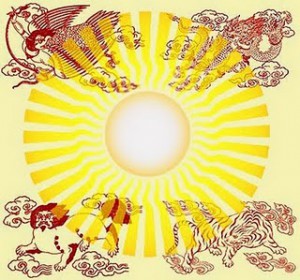Thursday
Community Articles, Dharma TeachingsMythology and Everyday Life
I’ve been wondering lately what Joseph Campbell would think of Shambhala Buddhism. He attributed many of the problems we face today, particularly our disconnect from nature and the resultant chaos & confusion found in our global society, to a lack of a working mythology. A working mythology uses metaphor & ritual as a means to discover & experience the deeper truths of phenomena & existence. Western mythology lost this ability when it was frozen (i.e., not continually updated & adapted to our changing times & scientific discoveries) and made a literal & historical set of doctrines & beliefs.
The Kalapayana of Shambhala Buddhism (the teachings & practices stemming from the Dorje Dradul’s discovery & promulgation of the Shambhala terma) seems (to me) to address these concerns quite beautifully. The Rigden King, rather than being an external deity to be believed in literally and worshiped, is a personification of our most basic nature. The Rigden’s iconography is symbolic of a being manifesting an enlightened nature that is inseparable from our own.
The four dignities: tiger, lion, garuda, and dragon, though a progressive path of further & deeper realization, are also, as a whole, the four aspects of an enlightened individual. The tiger, which corresponds to the hinayana level of traditional Buddhism, contains teachings & practices that help the practitioner cultivate & realize mindfulness, stability, and the discernment of what to accept and reject. The fruition of this level is contentment. The discovery of contentment leads to the impetus of one making a leap into the world to be of benefit to others. This dignity is represented by the snow lion (and corresponds to the mahayana path), and is characterized by an uplifted and joyful mind that is an effect of the confidence caused by the realizations of the level of tiger. The outrageousness of the garuda and the inscrutability of the dragon are further, and more profound, manifestations of the practitioner as she moves beyond fear, further connecting to the spacious & luminous qualities of the phenomenal world, and becoming unfathomable to the conventional mind.
The purpose of this set of teachings & practices (which is grounded, by the way, in establishing a strong daily practice of sitting meditation) is individual and cultural transformation. This summer, Sakyong Mipham Rinpoche (the Dharma King and head of Shambhala Buddhism) has been repeatedly emphasizing that we must deeply & experientially realize the fundamental truths that our practices & methods are pointing to, so that we may engage our world fully and skillfully in order that we may transform & uplift our culture- before it’s too late.
Societal change has been at the forefront of the Sakyong’s message this summer. We are in danger of falling into one of two extremes: On one hand, it is possible that we live our lives in ignorant-bliss, hoping that society will get better in some magical way on its own. Another common pitfall is that we see the situation of society as unwinnable. Our thoughts & attitudes about society, Rinpoche explained, greatly effect our action (or inaction) and, by extension, our impact & ability to initiate meaningful social change. What is needed, as a starting ground, is a fundamental shift in our being (coming from our personal practice) that changes the way we view, experience, and engage our world. This begins, as Rinpoche said, with seeing the basic goodness of society and seeing it as a workable situation.
Rinpoche also reminded us that coming to a program, such as, Vajrayana Seminary is not an escape from life or the “real world.” It is a chance to create & model a small example of enlightened society. Witnessing and experiencing the mindfulness, generosity, kindness, and consideration for others at Vajrayana Seminary this summer, I was left thinking, “Wow, this is how it could be everywhere!” Rinpoche is suggesting that we familiarize ourselves with what the great thinkers from the fields of philosophy, psychology, and politics are (and have been) saying; also, that we find new ways to engage others in dialogue about social issues. He pointed to the “salons” of France that sparked revolutions and consisted of intellectuals and community members engaging in contemplation and discussions of pressing social issues, as a viable example for us to use in our own lives. As our own membership reaches a critical mass, and as we are capable of holding our seat through the conviction developed in our personal practice, we can confidently reach out to our world, not to convince others of anything or to become Shambhalians necessarily, but to manifest and share our experience of basic goodness and the workability of our social situation.






Jul 28, 2011
Reply
Yes, I think you’re right Jay. I probably didn’t emphasize the importance of study and cultivating the view enough here. We certainly need not re-invent the wheel. All three aspects of dharma practice: study/hearing the teachings, contemplation, and meditation are vital. Thank you for your comment.
Jul 28, 2011
Reply
This is good Travis. But I think that our change in attitude will not come about by formal ‘personal practice’ alone as you seem to suggest. Establishing the correct view is also essential, and we do that through study and contemplation of profound teachings. For example, while our own direct experience of Basic Goodness may be sporadic, it is still important to cultivate the view that Basic Goodness is constantly present and underlies everything. The teachings of the Shentong philosophical tradition of the Mahayana are there to help us with that view. To establish a correct view of Drala and Rigden, it is helpful to study the details of the Mind-Only school. All these wisdom teachings are available for us to deepen our understanding. Without studying them, I think gaining a profound transformation its much more difficult.